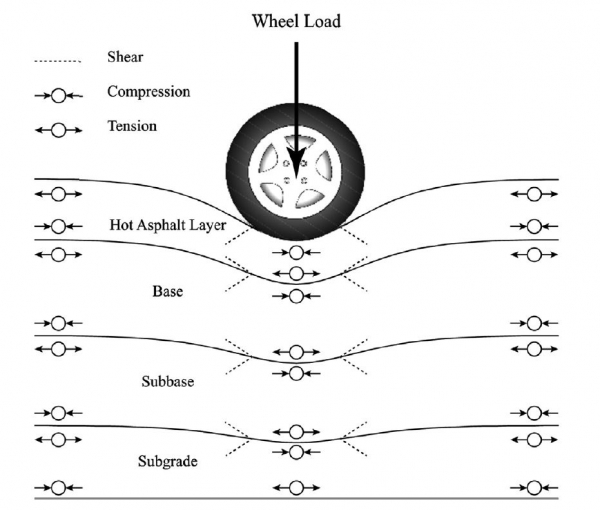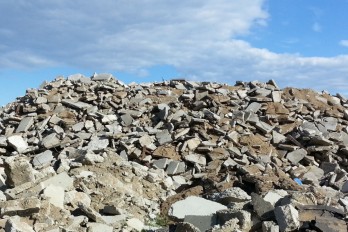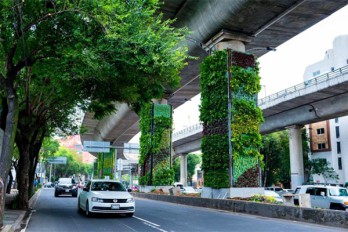Road bases constructed using buildings' debris and used tires

In an effort to make construction industry greener, a new study focuses on roads constructed by a material that is made of recycled buildings' debris and used tires.
A typical roadway comprises of 4 basic layers:
- A subgrade
- A base
- A sub-base and
- An asphalt layer
All those layers must withstand the forces applied by the vehicles and must also not experience significant subsidence, a fact that would lead to road anomalies or cracks.
The new mix is expected to be utilized as a base material and has never been studied before. It was developed by researchers from RMIT University in Melbourne, Australia and an experimental study on its shear behaviour was recently published.
Currently, the construction industry, including demolition and renovation projects, is responsible for about 50% of the total waste produced worldwide. Despite a global attempt to recycle construction and tires waste is currently underway, both industries are far from satisfied the equilibrium. Given that around 1 billion waste tires are generated annually, the need for a manner to recycle and re-use those materials again is crucial and the unique solution to overcome waste accumulation.
In Australia, the government decided to stop the export of specific waste materials in order to increase the country's capability of recycling. In addition, it will be completely prohibited to export used tires as of December 2021.
The research team conducted a series of large-scale direct shear tests (LDST) using special machinery to examine the effect of different amounts and sizes of the recycles tires on the shear strength of the material. Regarding the material's capability of replacing normal roadway base layer, they found that mixes "with two different sizes (i.e., fine and coarse rubber) and three different percentages (i.e., 0.5%, 1% and 2%) of crumb rubber satisfied the shear strength requirements for use in pavement base/subbase applications."
The mixture that acquired the higher shear strength consisted of 0.5% fine crumb rubber and 99,5 recycled concrete aggregate.
Moreover, the material proved to be better in another aspect compared to typical road bases that are made of quarried rock and sand. In particular, it presented high flexibility that would lead to less road cracking. “As we push towards a circular economy that can eliminate waste and support the continual use of resources, our recycled blend is the right choice for better roads and a better environment,” Dr. Mohammad Boroujeni, lead author of the study and a research assistant at RMIT university, stated.
Source: RMIT
Source: RMIT
Want to read more like this story?

3D-printed buildings using soil material
Sep, 24, 2020 | NewsResearchers have developed a new technique to construct a building using a 3-D printer and soil mate...

Recycled aggregate concrete as an alternative to conventional concrete
Nov, 30, 2020 | NewsA new research focuses on the potential of concrete made of recycled aggregates and compares its per...

What about recycled concrete?
Feb, 01, 2016 | NewsA group of scientists examines the possibility of using materials from demolitions for the construct...

Michelin proposes an airless, 3D printed, environment-friendly wheel for the driverless age
Apr, 05, 2018 | NewsThe dream-tires would be made from biodegradable materials and last as long as the vehicle The drea...

New method to transform construction waste into useful materials
Dec, 07, 2018 | NewsA group of German researchers has found a way to manipulate construction waste by turning them into...

Scientists produce high bending capacity concrete using no cement
Mar, 11, 2020 | NewsScientists from Swinburne University in Melbourne, Australia, have created a new concrete material t...

Improving concrete's fire resistance with tire fibers
Feb, 28, 2019 | NewsIn a new study, researchers have developed a method to improve concrete's performance when subjected...

New study shows that plastic waste can replace sand in concrete
Sep, 21, 2018 | NewsAccording to researchers from Bath University, waste plastic can replace some of the sand used in co...

Asphalt made of used tires
Dec, 20, 2018 | NewsA German company utilizes used tires to produce high quality asphalt. A German company utilizes use...
Trending

Vertical gardens in Mexico City to combat pollution

Characteristics of Load Bearing Masonry Construction

Taipei 101’s impressive tuned mass damper

Dutch greenhouses have revolutionized modern farming

The Line at Neom faces feasibility reassessment while construction continues

The Line at Neom faces feasibility reassessment while construction continues

King Salman Gate unveiled adjacent to Mecca’s Grand Mosque

